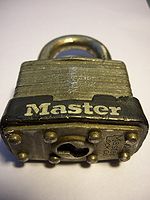Master Lock No 1: Difference between revisions
mNo edit summary |
m (→Master Lock No. 1: specs) |
||
| (4 intermediate revisions by 3 users not shown) | |||
| Line 11: | Line 11: | ||
| patent = | | patent = | ||
| related = | | related = | ||
| spec_on = true | |||
| spec_comptype = [[Pin_tumbler |Pin-tumbler]] | |||
| spec_comp = 4 | |||
}} | }} | ||
| Line 18: | Line 22: | ||
__TOC__ | __TOC__ | ||
<br clear=all> | |||
== Principles of operation == | == Principles of operation == | ||
| Line 53: | Line 58: | ||
== See also == | == See also == | ||
* [[Master Lock]] | |||
* [[Padlock]] | * [[Padlock]] | ||
* [[Pin-tumbler]] | * [[Pin-tumbler]] | ||
[[Category:Lock models]] | |||
[[Category:Master Lock]] | |||
[[Category:Padlocks]] | [[Category:Padlocks]] | ||
[[Category:Pin-tumbler locks]] | [[Category:Pin-tumbler locks]] | ||
Latest revision as of 13:55, 26 December 2022
Master Lock No. 1
| Master Lock No. 1 | |
 | |
| Name | Master Lock No. 1 |
|---|---|
| Manufacturer | Master Lock |
| Lock Type | Padlock, Cylinder |
| Lock Design | Pin-tumbler |
| Specifications | |
| # of Components | 4 |
| Component Type | Pin-tumbler |
The No. 1 is a pin-tumbler padlock made by Master Lock. The No. 1 uses a laminated padlock body with an internal key-in-knob-style cylinder. The inner cylinder uses four pin stacks and does not use any security pins.
The No. 1 is one of the most common low security padlocks used in the United States.
Principles of operation
The No. 1 cylinder is a pin-tumbler lock with four pin stacks and no security pins. The cylinder typically uses the M1 key profile but may use other profiles, as well. The standard No. 1 can be opened in both directions but the "commercial" series body restricts opening to clockwise rotation. The No. 1 is not a key retaining padlock.
Disassembly instructions
The No. 1 cannot be disassembled non-destructively. To disassemble it the rivets that hold the laminated body together must be removed and each layer removed individually. The inner cylinder itself can be disassembled in the same manner as a traditional pin-tumbler lock:
- Remove the cam or C-clip.
- Insert the key and turn the plug 45-90 degrees.
- Withdraw the plug from the cylinder. (A plug follower is recommended)
OR
- Remove the chamber casings and take out each pin-stack individually
- Remove the cam or C-clip.
- Withdraw the plug from the cylinder.
Notes
- The No. 1 cylinder requires a small diameter plug follower.
- The No. 1 plug is retained by a crimp, rather than a C-clip or cam. Above are the generic pin-tumbler disassembly instructions.
Vulnerabilities
The No. 1 is vulnerable to a wide range of attacks. The reduced pin tumbler count and poor manufacturing tolerances makes it an easy lock to pick. It's commonly given to locksport beginners as a "confidence lock"; a lock that is easy to open and inspires you to continue picking. The No. 1 may be vulnerable to one or more of the following:

